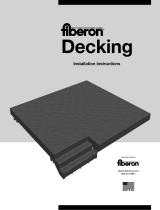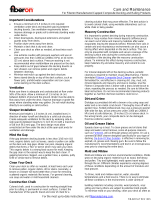
Hidden Fasteners
FASTENERS RECOMMENDED FOR USE WITH
FIBERON GV DECKING include Phantom Hidden
Fasteners and Phantom End Clip Hidden Fasteners. Fiberon
Paramount square edge decking requires the use of Fiberon
Cortex Screws, the only approved hidden face fasteners
recommended for Paramount decking. Fiberon Cortex
screws are available in all five colors of Paramount Decking.
Wood Grain Patterns
Note that the wood grain patterns on Fiberon decking are
directional. Different looks can be achieved by laying the
decking in the same or alternating directions. There are
several different wood grain patterns. See Figure 10 below
for one of these patterns.
The graining pattern repeats approximately every 44" (1.12
m) feet along the board length. To ensure you orient the
boards to achieve the desired effect, a directional label is
noted on the side of each board showing grain direction.
During the planning phase of any deck project, arrange
decking before installation to achieve the desired pattern
and color effect (Figure 11). This is also important if different
lengths/bundles of material are used as different wood grain
patterns and color tones may need to be mixed to achieve
the desired look.
Ventilation
Do not install decking directly to a solid surface. Make sure
there is adequate and unobstructed air flow under the deck
to prevent excessive water absorption. Improve drainage
or grade flat areas where standing water may gather. Allow
a minimum of 6" (15 cm) between the bottom of the deck
substructure/joists and the ground. The deck design must
allow unrestricted airflow under at least 50% of its perimeter
to permit adequate ventilation.
Fascia Installation
Fascia is intended as a non-structural covering for rim
joists, risers and stringers. Screws should be installed at a
maximum 12" (30 cm) interval, with three screws across the
face at each interval (Figure 12). For Paramount, also apply
a zigzag bead of high quality exterior adhesive to the entire
length of the back (smooth side) of the board, within 2" (5
cm) of the edges and ends. Do not over-tighten screws as
buckling and cracking may result. Install with 1/8" (3 mm)
spacing between the edges and ends in temperatures
above 50˚ F (10˚ C). Leave 3/16" (5 mm) space between
edges and ends in temperatures below 50˚ F (10˚ C).
Fire and Unusual Heat Sources
Composite decking will retain heat when exposed to direct
or reflective sunlight. Exercise caution if walking barefoot as
footwear may be required. Fire and unusual sources of heat
and heat buildup can potentially damage Fiberon decking
surfaces. Examples would include fire, reflected light from
different types of glass (ex. low-e glass), fire features and
under-deck waterproofing installations that do not provide
the 6" (15 cm) of un-obstructed net free ventilation.
• Low-E Glass/Reected Heat
Low-emissivity glass is designed to prevent heat gain
inside the house by reflecting sunlight outward. This
reflective property can result in excessive heat buildup on
the surface of Fiberon decking and on exterior surfaces.
When the sunlight is reflected and concentrated it can
harm a range of building materials that include doors,
windows, siding, trim and decking. Damage caused to
For the most up-to-date instructions, visit fiberondecking.com.
Fiberon
®
Decking Installation Instructions
10
Same Direction
Wood Grain Orientation
During Installation
Alternating Direction
11
12"
Proper Fascia Installation
12
5















